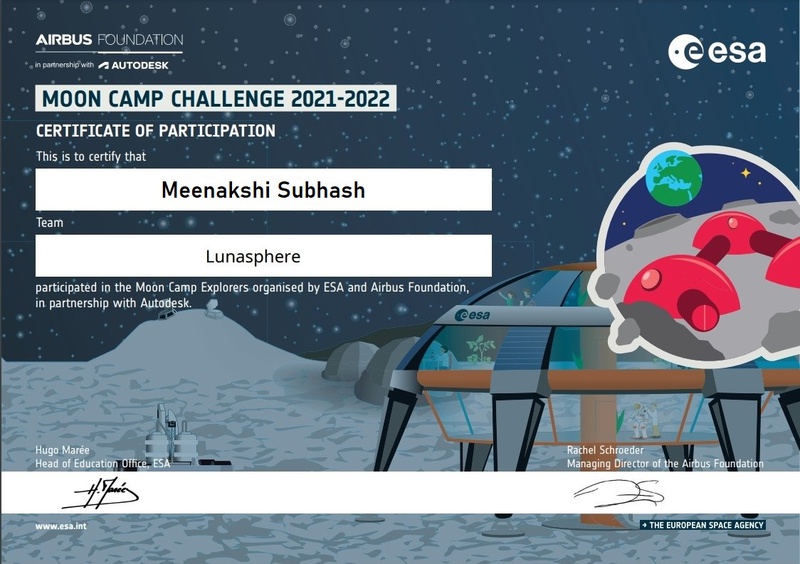Lunasphere's lunar base Project
About project:
This base is called Lunasphere as this is located on the moon with earth like pressure and atmosphere. There are 5 astronauts, staying there for 8 months. The camp is protected from the sun's radiation and tiny meteorites. We mainly conduct experiments on living organisms and lunar soil suggested by agencies and universities. We have a big dome called the biosphere, which has living quarters, laboratory, plantation area and food storage chamber (both grown and earth supplied food). During the solar event astronauts enter the emergency quarters located in the lava tube as it can support astronauts for 3-4 days. There are communication quarters that help in sending and receiving commands and data from the earth. We have a well-equipped hospital wing for medical emergencies. There is a space observatory for observing the universe. There are smelters and 3D printers that help in building different structures. We have launch pads for the rockets to land on and launch from the moon. The monitoring quarters give the details about the camp. Lastly, we have the mains, the main purification and generating centre. There is a helium reactor, waste management and air tanks, the mains will supply these resources to the base through underground connections. We produce helium through the lunar soil and use it for our He3 reactor that is implemented. Also, we grow and test microorganisms to see which are capable of adapting to the moon’s atmosphere. While doing this, we may also develop new species.
Where do you want to build your Moon Camp?
We want to build our moon camp close to the lunar poles.
Why did you choose this location?
We chose the South Pole for our moon camp because its craters are rich in water that's found in the form of ice. It is also extremely helpful for our astronaut crew to arrive near these craters because water is extremely scarce on the moon's surface due to the sun's radiation, which strips unprotected water to its elementary molecules. The disadvantage is that no moon surface receives perpetual sunlight, but still we have solar panels to release energy. But we manage to produce enough energy on the moon with he3 reactor.
How do you plan to build your Mooncamp? Which materials will you use?
The structures of the camp are built using lunar soil (regolith) with multiple layers for protection and thermal insulation. At first, a capsule lands containing: rovers, a 3D printer, communication, and cameras to monitor the work. The regolith is collected by the rover for printing structures. Then it will be transported to the printer; it prints the structures according to the command sent from earth. Once main structures are built astronauts are sent to: add layers of insulation, instrument, connect the air, water and power supply lines. During the progress the astronauts will be staying in their lander.
How do you plan to provide the astronauts with the follwoing things?
Water
Water can be found within lunar tunnels and caves. It's also found inside craters that are permanently dark because of their proximity to the poles. The water will be used in the layers of protection, by astronauts, plants, waste water treatment plant etc. there is a cycle between these applications of water. The water is heated, purified, and sent to the electrolysis chamber and mineralized.
Food
We grow food such as microgreens, potatoes etc. as they can be harvested quickly. The seeds will be glued to the layers of soil, there are led lights that dim according to the time so that it could perform both photosynthesis and respiration. Both oxygen and carbon dioxide are supplied for the plants. The water ports are present under the soil bed. Before the grown food is stored it is dehydrated and powdered. Additionally, the food from the earth are categorised in different chambers according to their shelf life and maintained at a particular temperature.
Electricity
Our best bet is creating a sun in our base i.e. using a fusion reactor. It requires an atom to have enough kinetic energy so that it can come close enough so that its strong nuclear force pulls them together stronger than the electromagnetism which pushes them apart. This can be achieved either using a particle accelerator or by heating it hot. It is also relatively safe i.e. if containment is breached the plasma of fusion fuel will dissipate instantly. It is efficient as 1 kg of fusion fuel is equal to burning 10million kilos of fossil fuels.
Air
Oxygen is taken from plants and also from electrolysis. Carbon dioxide is also important for plants. We use dry ice and it is also taken from plants when they respire. Pre-coded computers are used to automatically control amount of air supply, ratios of air etc. Nitrogen is also another important gas for plants to synthesise protein, so we will use nitrogenous fertilisers collected after the waste management. If there is any problem while supplying air to the base, astronauts will use an oxygen candle. The atmospheric pressure maintained in the base is 1bar with the help of airlocks between chambers.
Protection
Protection from the sun’s radiation is ensured by coating the base with kevlar, aluminium, lead, titanium, and space grade plastic. We have planned to give the coating with the layers of fabrics used in a spacesuit as it is also efficient for protecting the astronauts while exposed to the sun directly. And these all layers also help in protecting the base from tiny meteorites. We will also have a layer of water for cooling and the hydrogen in water protects the camp from radiation threats.
Describe a day on the Moon for one of your Moon Camp astronauts
Astronauts follow the earth's time so that their biological clock won’t change.
7:00 the astronauts will wake up
7:30-8:30 workout
9:00 have their breakfast
9:30 get to work by monitoring and checking the power, water supply etc.
12:30 comeback for having lunch
1:00-3:00 have their rest
3:30 return back to their daily check
5:30 return to their living quarters
7:00-8:00 have some entertainment through books or talk with their family
8:30 have their dinner
9:00 get to sleep for another working day

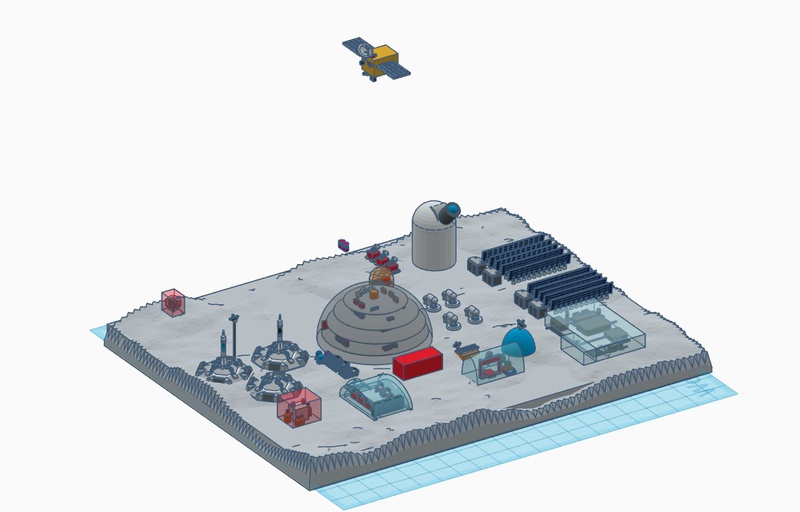
About Team:
I am Dhivyashree Loganathan
I am Arnav Filip Saxena
I am Adith Raghav
I am Arjuna Sankar
I am Meenakshi Subhash
This base is called Lunasphere as this is located on the moon with earth like pressure and atmosphere. There are 5 astronauts, staying there for 8 months. The camp is protected from the sun's radiation and tiny meteorites. We mainly conduct experiments on living organisms and lunar soil suggested by agencies and universities. We have a big dome called the biosphere, which has living quarters, laboratory, plantation area and food storage chamber (both grown and earth supplied food). During the solar event astronauts enter the emergency quarters located in the lava tube as it can support astronauts for 3-4 days. There are communication quarters that help in sending and receiving commands and data from the earth. We have a well-equipped hospital wing for medical emergencies. There is a space observatory for observing the universe. There are smelters and 3D printers that help in building different structures. We have launch pads for the rockets to land on and launch from the moon. The monitoring quarters give the details about the camp. Lastly, we have the mains, the main purification and generating centre. There is a helium reactor, waste management and air tanks, the mains will supply these resources to the base through underground connections. We produce helium through the lunar soil and use it for our He3 reactor that is implemented. Also, we grow and test microorganisms to see which are capable of adapting to the moon’s atmosphere. While doing this, we may also develop new species.
Where do you want to build your Moon Camp?
We want to build our moon camp close to the lunar poles.
Why did you choose this location?
We chose the South Pole for our moon camp because its craters are rich in water that's found in the form of ice. It is also extremely helpful for our astronaut crew to arrive near these craters because water is extremely scarce on the moon's surface due to the sun's radiation, which strips unprotected water to its elementary molecules. The disadvantage is that no moon surface receives perpetual sunlight, but still we have solar panels to release energy. But we manage to produce enough energy on the moon with he3 reactor.
How do you plan to build your Mooncamp? Which materials will you use?
The structures of the camp are built using lunar soil (regolith) with multiple layers for protection and thermal insulation. At first, a capsule lands containing: rovers, a 3D printer, communication, and cameras to monitor the work. The regolith is collected by the rover for printing structures. Then it will be transported to the printer; it prints the structures according to the command sent from earth. Once main structures are built astronauts are sent to: add layers of insulation, instrument, connect the air, water and power supply lines. During the progress the astronauts will be staying in their lander.
How do you plan to provide the astronauts with the follwoing things?
Water
Water can be found within lunar tunnels and caves. It's also found inside craters that are permanently dark because of their proximity to the poles. The water will be used in the layers of protection, by astronauts, plants, waste water treatment plant etc. there is a cycle between these applications of water. The water is heated, purified, and sent to the electrolysis chamber and mineralized.
Food
We grow food such as microgreens, potatoes etc. as they can be harvested quickly. The seeds will be glued to the layers of soil, there are led lights that dim according to the time so that it could perform both photosynthesis and respiration. Both oxygen and carbon dioxide are supplied for the plants. The water ports are present under the soil bed. Before the grown food is stored it is dehydrated and powdered. Additionally, the food from the earth are categorised in different chambers according to their shelf life and maintained at a particular temperature.
Electricity
Our best bet is creating a sun in our base i.e. using a fusion reactor. It requires an atom to have enough kinetic energy so that it can come close enough so that its strong nuclear force pulls them together stronger than the electromagnetism which pushes them apart. This can be achieved either using a particle accelerator or by heating it hot. It is also relatively safe i.e. if containment is breached the plasma of fusion fuel will dissipate instantly. It is efficient as 1 kg of fusion fuel is equal to burning 10million kilos of fossil fuels.
Air
Oxygen is taken from plants and also from electrolysis. Carbon dioxide is also important for plants. We use dry ice and it is also taken from plants when they respire. Pre-coded computers are used to automatically control amount of air supply, ratios of air etc. Nitrogen is also another important gas for plants to synthesise protein, so we will use nitrogenous fertilisers collected after the waste management. If there is any problem while supplying air to the base, astronauts will use an oxygen candle. The atmospheric pressure maintained in the base is 1bar with the help of airlocks between chambers.
Protection
Protection from the sun’s radiation is ensured by coating the base with kevlar, aluminium, lead, titanium, and space grade plastic. We have planned to give the coating with the layers of fabrics used in a spacesuit as it is also efficient for protecting the astronauts while exposed to the sun directly. And these all layers also help in protecting the base from tiny meteorites. We will also have a layer of water for cooling and the hydrogen in water protects the camp from radiation threats.
Describe a day on the Moon for one of your Moon Camp astronauts
Astronauts follow the earth's time so that their biological clock won’t change.
7:00 the astronauts will wake up
7:30-8:30 workout
9:00 have their breakfast
9:30 get to work by monitoring and checking the power, water supply etc.
12:30 comeback for having lunch
1:00-3:00 have their rest
3:30 return back to their daily check
5:30 return to their living quarters
7:00-8:00 have some entertainment through books or talk with their family
8:30 have their dinner
9:00 get to sleep for another working day


Name: Dhivyashree Loganathan
Age: 12

Name:Arnav Filip Saxena
Age: 12
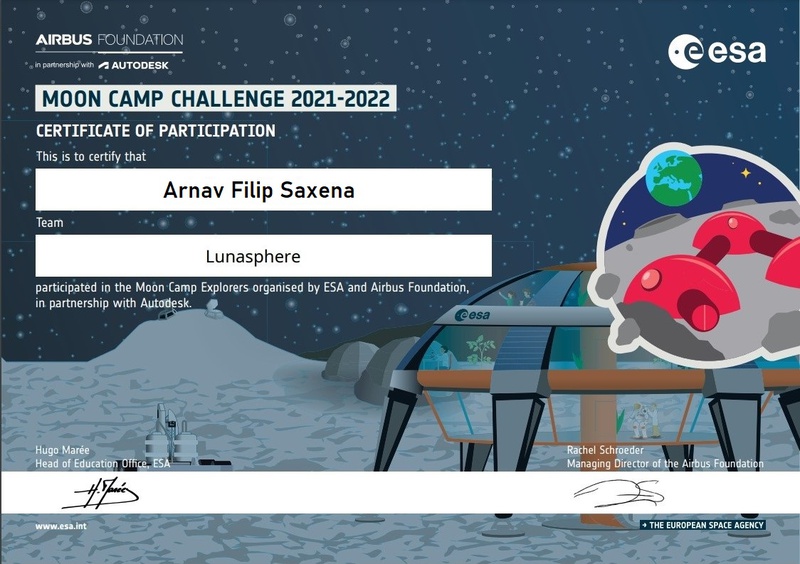
Name:Adith Raghav
Age: 12
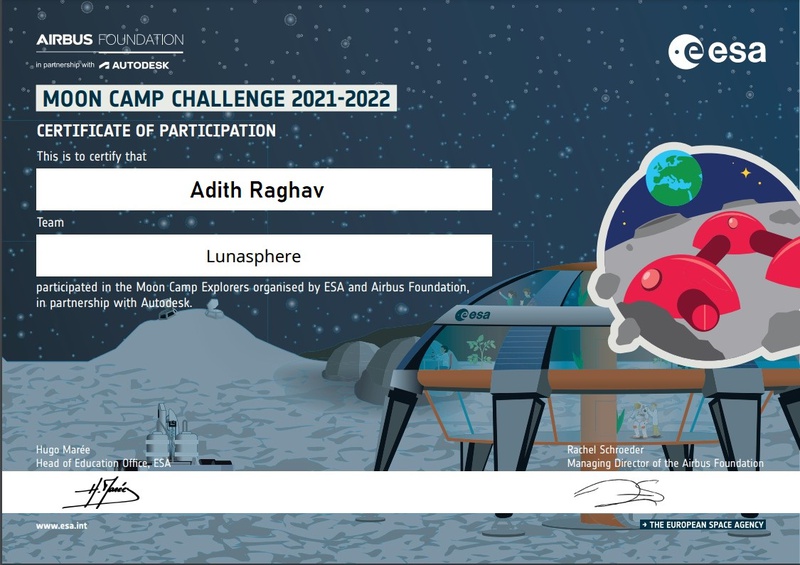
Name:Arjuna Sankar
Age: 13
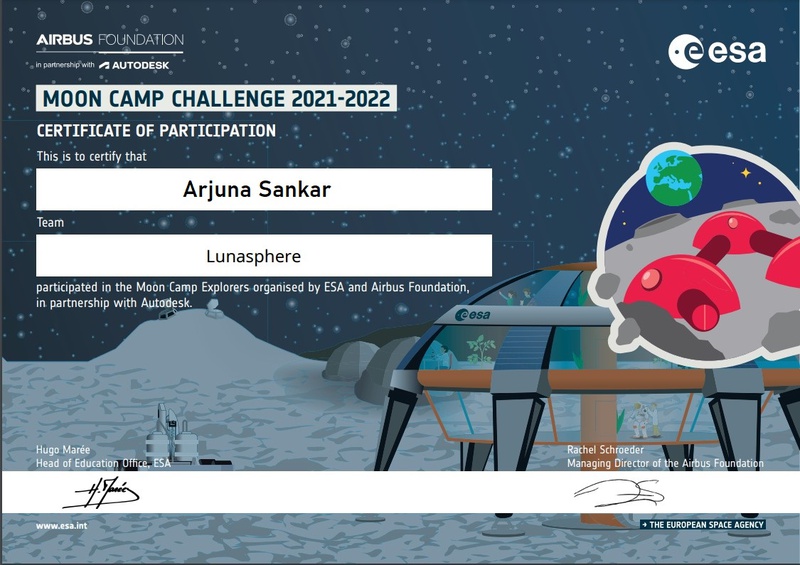
Name:Meenakshi Subhash
Age: 11
